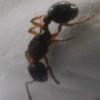Was working in office with porch door open and ants started flying in to the computer monitor's light. Two distinct species.
Location: Seattle, WA suburbs
Time: 9:30 PM - 10:30 PM
Weather: Heavy day of rain three days ago, sunny since; high 80s F today, 74 F at time of flight
First species is tetramorium. I think. Completely black and 2 - 2.5 mm. Caught 17 and put each one in its own ziplock bags, in cool basement, until test tubes arrive Friday.
The other species is TINY! Golden in color about 1 mm or less, they almost looked like fruit flies. Gave two their own isolated bags, and put about 15 all together in one tupperware, and another 15 in another tupperware.
In the tupperwares, they appear to be fighting a little bit. That, or they're kissing--which I'm sure they're not. I'm worried that they'll all kill each other before I can put them in test tubes on Friday. What do you guys think? Is fighting typical for multiple queens in a single temporary container?
Will post pictures when I get them in test tubes.
Edited by prettycode, July 31 2015 - 7:42 AM.


















